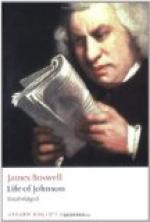JULY 31. We went to church at St. Asaph. The Cathedral, though not large, has something of dignity and grandeur. The cross aisle is very short. It has scarcely any monuments. The Quire has, I think, thirty-two stalls of antique workmanship. On the backs were CANONICUS, PREBEND, CANCELLARIUS, THESAURARIUS, PRAECENTOR. The constitution I do not know, but it has all the usual titles and dignities. The service was sung only in the Psalms and Hymns.
The Bishop was very civil[1191]. We went to his palace, which is but mean. They have a library, and design a room. There lived Lloyd[1192] and Dodwell[1193].
AUGUST 1.
We visited Denbigh, and the remains of its Castle.
The town consists of one main street, and some that cross it, which I have not seen. The chief street ascends with a quick rise for a great length: the houses are built, some with rough stone, some with brick, and a few are of timber.
The Castle, with its whole enclosure, has been a prodigious pile; it is now so ruined, that the form of the inhabited part cannot easily be traced.
There are, as in all old buildings, said to be extensive vaults, which the ruins of the upper works cover and conceal, but into which boys sometimes find a way. To clear all passages, and trace the whole of what remains, would require much labour and expense. We saw a Church, which was once the Chapel of the Castle, but is used by the town: it is dedicated to St. Hilary, and has an income of about—
At a small distance is the ruin of a Church said to have been begun by the great Earl of Leicester[1194], and left unfinished at his death. One side, and I think the east end, are yet standing. There was a stone in the wall, over the door-way, which it was said would fall and crush the best scholar in the diocese. One Price would not pass under it[1195]. They have taken it down.
We then saw the Chapel of Lleweney, founded by one of the Salusburies: it is very compleat: the monumental stones lie in the ground. A chimney has been added to it, but it is otherwise not much injured, and might be easily repaired.
We went to the parish Church of Denbigh, which, being near a mile from the town, is only used when the parish officers are chosen.
In the Chapel, on Sundays, the service is read thrice, the second time only in English, the first and third in Welsh. The Bishop came to survey the Castle, and visited likewise St. Hilary’s Chapel, which is that which the town uses. The hay-barn, built with brick pillars from space to space, and covered with a roof. A more[1196] elegant and lofty Hovel.
The rivers here, are mere torrents which are suddenly swelled by the rain to great breadth and great violence, but have very little constant stream; such are the Clwyd and the Elwy. There are yet no mountains. The ground is beautifully embellished with woods, and diversified by inequalities.




